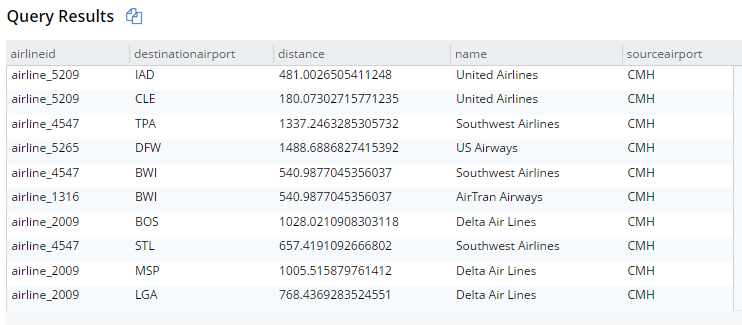SELECT r.destinationairport, r.sourceairport, r.distance, r.airlineid, a.name
FROM `travel-sample` r
JOIN `travel-sample` a ON KEYS r.airlineid
WHERE r.type = 'route'
AND r.sourceairport = 'CMH'
ORDER BY r.distance DESC
LIMIT 10;Posts tagged with 'nes'
Andrea Cremese wrote a dissertation on developer motivation.
Show Notes:
-
Frederick Herzberg talks about "hygiene factors" in the book: Motivation to Work
-
Check out episode 36 on the film Pirates of Silicon Valley for some talk about Xerox PARC
-
Some positive examples, per Andrea:
-
Satya Nadella, CEO of Microsoft
-
Amazon
-
Smartsheet
-
-
Glassdoor is a site where employees review their employer. I’m not terribly keen on it, especially when there is a small sample size, but it could be a useful tool in some situations.
-
Dan Ariely was mentioned, check out his TED talk What makes us feel good about our work?
-
Some quotes regarding Ariely that Andrea wanted me to share:
-
Large Stakes and Big Mistakes, (Dan Ariely one of the authors), quote: "Workers in a wide variety of jobs are paid based on performance, which is commonly seen as enhancing effort and productivity relative to non-contingent pay schemes. However, psychological research suggests that excessive rewards can, in some cases, result in a decline in performance. To test whether very high monetary rewards can decrease performance, we conducted a set of experiments in the U.S. and in India in which subjects worked on different tasks and received performance-contingent payments that varied in amount from small to very large relative to their typical levels of pay. With some important exceptions, very high reward levels had a detrimental effect on performance."
-
Does money really motivate people?, quotes: "But maybe the small sums involved in Ariely’s example and Deci’s experiments undermine their application to real-world international business and finance. To address this, Ariely and colleagues, recruited villagers in India to play games testing memory, creativity and motor skills, offering three different groups four, 40 or 400 rupees per game for scoring highly. The maximum reward was equivalent to the amount spent by the average person living in rural India in five months. They found that those offered the highest incentives performed worst, earning an average of 20% of the maximum possible, compared to around 36% for those in the low and medium reward groups. "Our results challenge the assumption that an increase in motivation would necessarily lead to improvements in performance," says Ariely."
-
And: "If I gave you a bigger bonus to jump you would jump more times," says Ariely. "You have very good control over your legs and if I give you more money you will transmit more power to them and therefore you will be more successful. We don’t have the same control over memory, creativity and concentration. You can’t will yourself into a higher state of concentration and creativity. It’s actually counterproductive and hinders performance strongly." Anyone that has tried to force themselves to concentrate can probably relate to those findings. But there are also more subtle effects of motivation that can be teased apart using these new techniques.""
-
-
In the same vein as Pirates of Silicon Valley, check out The Triumph of the Nerds
-
Halt and Catch Fire! You should check this show out. I personally can’t get enough of the opening theme. Here’s a part of one my favorite scenes in the series (minor spoiler alert if you haven’t watched any of the show)
-
Not related to the dissertation at all, but check out Better Call Saul (NSFW language)
Want to be on the next episode? You can! All you need is the willingness to talk about something technical.
Music is by Joe Ferg, check out more music on JoeFerg.com!
Thanks to tremendous response, I’ve got a ton of great guests lined up.
Reminders:
-
Be sure to check out my sponsor: Smartsheet! Thanks to them, I’m able to afford some new equipment, more hosting, and the JavaScript game show prizes!
-
If you’re enjoying the new JavaScript game show, please send in your suggestions. I’m running out of ideas, and you and your ideas could be featured on this show. I need real and made-up suggestions! The sillier the names, the better.
Subscribe now!
Here’s what’s coming in March:
-
David Giard is returning to talk more cognitive services
-
Chase Aucoin on the Microservices Manifesto
-
Andrea Cremese returns to talk developer retention
-
Jeffrey Miller returns to talk about authoring a children’s book
-
Craig Stuntz returns to talk .NET IL
Subscribe now with your podcatcher of choice!
Want to be on the next episode? You can! All you need is the willingness to talk about something technical.
Andrea Cremese is building and using Saas.
Show Notes:
-
The Henry Ford quote appears to be apocryphal: Henry Ford, Innovation, and That “Faster Horse†Quote
-
Podcast: The Top by Nathan Latka
-
Interview with Aaron Levy, the CEO of box
-
Movie: Abacus: small enough to jail
Want to be on the next episode? You can! All you need is the willingness to talk about something technical.
Music is by Joe Ferg, check out more music on JoeFerg.com!
This is a repost that originally appeared on the Couchbase Blog: New Querying Features in Couchbase Server 5.5.
New querying features figure prominently in the latest release of Couchbase Server 5.5. Check out the announcement and download the developer build for free right now.
In this post, I want to highlight a few of the new features and show you how to get started using them:
-
ANSI JOINs - N1QL in Couchbase already has JOIN, but now JOIN is more standards compliant and more flexible.
-
HASH joins - Performance on certain types of joins can be improved with a HASH join (in Enterprise Edition only)
-
Aggregate pushdowns - GROUP BY can be pushed down to the indexer, improving aggregation performance (in Enterprise Edition only)
All the examples in this post use the "travel-sample" bucket that comes with Couchbase.
ANSI JOINs
Until Couchbase Server 5.5, JOINs were possible, with two caveats:
-
One side of the JOIN has to be document key(s)
-
You must use the
ON KEYSsyntax
In Couchbase Server 5.5, it is no longer necessary to use ON KEYS, and so writing joins becomes much more natural and more in line with other SQL dialects.
Previous JOIN syntax
For example, here’s the old syntax:
This will get 10 routes that start at CMH airport, joined with their corresponding airline documents. The result are below (I’m showing them in table view, but it’s still JSON):

New JOIN syntax
And here’s the new syntax doing the same thing:
SELECT r.destinationairport, r.sourceairport, r.distance, r.airlineid, a.name
FROM `travel-sample` r
JOIN `travel-sample` a ON META(a).id = r.airlineid
WHERE r.type = 'route'
AND r.sourceairport = 'CMH'
ORDER BY r.distance DESC
LIMIT 10;The only difference is the ON. Instead of ON KEYS, it’s now ON <field1> = <field2>. It’s more natural for those coming from a relational background (like myself).
But that’s not all. Now you are no longer limited to joining just on document keys. Here’s an example of a JOIN on a city field.
SELECT a.airportname, a.city AS airportCity, h.name AS hotelName, h.city AS hotelCity, h.address AS hotelAddress
FROM `travel-sample` a
INNER JOIN `travel-sample` h ON h.city = a.city
WHERE a.type = 'airport'
AND h.type = 'hotel'
LIMIT 10;This query will show hotels that match airports based on their city.

Note that for this to work, you must have an index created on the field that’s on the inner side of the JOIN. The "travel-sample" bucket already contains a predefined index on the city field. If I were to attempt it with other fields, I’d get an error message like "No index available for ANSI join term…".
For more information on ANSI JOIN, check out the full N1QL JOIN documentation.
Note: The old JOIN, ON KEYS syntax will still work, so don’t worry about having to update your old code.
Hash Joins
Under the covers, there are different ways that joins can be carried out. If you run the query above, Couchbase will use a Nested Loop (NL) approach to execute the join. However, you can also instruct Couchbase to use a hash join instead. A hash join can sometimes be more performant than a nested loop. Additionally, a hash join isn’t dependent on an index. It is, however, dependent on the join being an equality join only.
For instance, in "travel-sample", I could join landmarks to hotels on their email fields. This may not be the best find to find out if a hotel is a landmark, but since email is not indexed by default, it illustrates the point.
SELECT l.name AS landmarkName, h.name AS hotelName, l.email AS landmarkEmail, h.email AS hotelEmail
FROM `travel-sample` l
INNER JOIN `travel-sample` h ON h.email = l.email
WHERE l.type = 'landmark'
AND h.type = 'hotel';The above query will take a very long time to run, and probably time out.
Syntax
Next I’ll try a hash join, which must be explicitly invoked with a USE HASH hint.
SELECT l.name AS landmarkName, h.name AS hotelName, l.email AS landmarkEmail, h.email AS hotelEmail
FROM `travel-sample` l
INNER JOIN `travel-sample` h USE HASH(BUILD) ON h.email = l.email
WHERE l.type = 'landmark'
AND h.type = 'hotel';A hash join has two sides: a BUILD and a PROBE. The BUILD side of the join will be used to create an in-memory hash table. The PROBE side will use that table to find matches and perform the join. Typically, this means you want the BUILD side to be used on the smaller of the two sets. However, you can only supply one hash hint, and only to the right side of the join. So if you specify BUILD on the right side, then you are implicitly using PROBE on the left side (and vice versa).
BUILD and PROBE
So why did I use HASH(BUILD)?
I know from using INFER and/or Bucket Insights that landmarks make up roughly 10% of the data, and hotels make up about 3%. Also, I know from just trying it out that HASH(BUILD) was slightly slower. But in either case, the query execution time was milliseconds. Turns out there are two hotel-landmark pairs with the same email address.

USE HASH will tell Couchbase to attempt a hash join. If it cannot do so (or if you are using Couchbase Server Community Edition), it will fall back to a nested-loop. (By the way, you can explicitly specify nested-loop with the USE NL syntax, but currently there is no reason to do so).
For more information, check out the HASH join areas of the documentation.
Aggregate pushdowns
Aggregations in the past have been tricky when it comes to performance. With Couchbase Server 5.5, aggregate pushdowns are now supported for SUM, COUNT, MIN, MAX, and AVG.
In earlier versions of Couchbase, indexing was not used for statements involving GROUP BY. This could severely impact performance, because there is an extra "grouping" step that has to take place. In Couchbase Server 5.5, the index service can do the grouping/aggregation.
Example
Here’s an example query that finds the total number of hotels, and groups them by country, state, and city.
SELECT country, state, city, COUNT(1) AS total
FROM `travel-sample`
WHERE type = 'hotel' and country is not null
GROUP BY country, state, city
ORDER BY COUNT(1) DESC;The query will execute, and it will return as a result:

Let’s take a look at the visual query plan (only available in Enterprise Edition, but you can view the raw Plan Text in Community Edition).

Note that the only index being used is for the type field. The grouping step is doing the aggregation work. With the relatively small travel-sample data set, this query is taking around ~90ms on my single node desktop. But let’s see what happens if I add an index on the fields that I’m grouping by:
Indexing
CREATE INDEX ix_hotelregions ON `travel-sample` (country, state, city) WHERE type='hotel';Now, execute the above SELECT query again. It should return the same results. But:
-
It’s now taking ~7ms on my single node desktop. We’re taking ms, but with a large, more realistic data set, that is a huge difference in magnitude.
-
The query plan is different.

Note that this time, there is no 'group' step. All the work is being pushed down to the index service, which can use the ix_hotelregions index. It can use this index because my query is exactly matching the fields in the index.
Index push down does not always happen: your query has to meet specific conditions. For more information, check out the GROUP BY and Aggregate Performance areas of the documentation.
Summary
With Couchbase Server 5.5, N1QL includes even more standards-compliant syntax and becomes more performant than ever.
Try out N1QL today. You can install Enterprise Edition or try out N1QL right in your browser.
Have a question for me? I’m on Twitter @mgroves. You can also check out @N1QL on Twitter. The N1QL Forum is a good place to go if you have in-depth questions about N1QL.
How are you liking Season 3 so far? I'm having a blast!
Some reminders:
The new original music is by JoeFerg. Check out his stuff!
Have you checked out my sponsor yet? Smartsheet!
If you're enjoying the new JavaScript game show, please start sending in your suggestions. I'm running out of ideas, and you and your ideas could be featured on this show. I need real and made-up suggestions!
Subscribe now!
Here's what's coming in February:
- Stephen Clearly on Azure Functions
- Scott Drake on hiring programmers
- Jeffrey Miller on Neo4j
- Andrea Cremes on SaaS
Subscribe now with your podcatcher of choice!
Want to be on the next episode? You can! All you need is the willingness to talk about something technical.


